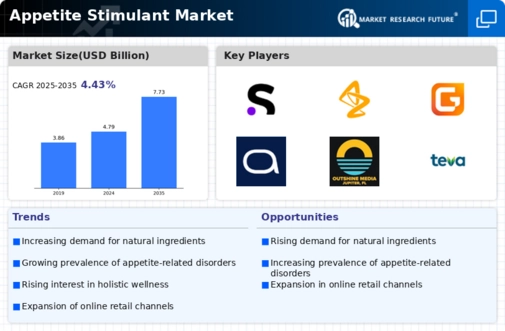Rising Geriatric Population
The rising geriatric population is a significant factor influencing the Appetite Stimulant Market. As individuals age, they often experience a decline in appetite due to various factors, including medical conditions and medication side effects. This demographic shift is leading to an increased demand for appetite stimulants that can help improve nutritional intake among older adults. Data indicates that the population aged 65 and older is projected to double by 2050, which suggests a growing market for appetite stimulants tailored to this age group. Healthcare providers are increasingly recognizing the importance of addressing appetite issues in the elderly, thereby driving the development and marketing of appetite stimulants designed specifically for this demographic.
Rising Incidence of Eating Disorders
The prevalence of eating disorders, such as anorexia and bulimia, has been on the rise, which appears to be a significant driver for the Appetite Stimulant Market. As more individuals seek treatment for these conditions, appetite stimulants are increasingly being prescribed to help restore normal eating patterns. According to recent data, the number of diagnosed cases of eating disorders has increased by approximately 30% over the past decade. This trend indicates a growing need for effective appetite stimulants, as healthcare providers look for solutions to assist patients in regaining their appetite and improving their nutritional intake. Consequently, the demand for appetite stimulants is likely to continue to grow as awareness of these disorders increases and treatment options expand.
Increased Focus on Pediatric Nutrition
The increased focus on pediatric nutrition is emerging as a notable driver for the Appetite Stimulant Market. Parents and healthcare professionals are becoming more aware of the nutritional needs of children, particularly those who are underweight or have difficulty eating. This awareness has led to a rise in the demand for appetite stimulants specifically formulated for children. Market analysis indicates that the pediatric segment of the appetite stimulant market is expected to grow by approximately 6% annually over the next few years. This growth is likely fueled by the increasing prevalence of childhood obesity and related health issues, prompting parents to seek solutions that can help their children maintain a healthy appetite and nutritional balance.
Advancements in Pharmaceutical Research
Recent advancements in pharmaceutical research are playing a crucial role in shaping the Appetite Stimulant Market. Innovative formulations and delivery methods are being developed to enhance the efficacy and safety of appetite stimulants. For instance, new compounds that target specific receptors in the brain are being explored, which may lead to more effective appetite stimulation with fewer side effects. This research is supported by a growing investment in the pharmaceutical sector, which has seen an increase of over 20% in funding for appetite-related drug development in the past few years. As these advancements continue to emerge, they are likely to attract more attention from healthcare providers and patients alike, further propelling the appetite stimulant market.
Growing Awareness of Nutritional Health
There is a burgeoning awareness regarding the importance of nutritional health, which seems to be influencing the Appetite Stimulant Market. Consumers are increasingly recognizing the role of proper nutrition in overall well-being, leading to a heightened interest in products that can enhance appetite. This trend is particularly evident among individuals with chronic illnesses, who often experience appetite loss due to their conditions. Market data suggests that the appetite stimulant segment is projected to grow at a compound annual growth rate of 5.5% over the next five years, driven by this increasing focus on nutritional health. As more people seek to improve their dietary habits, appetite stimulants are likely to become a more integral part of their health management strategies.


















Leave a Comment